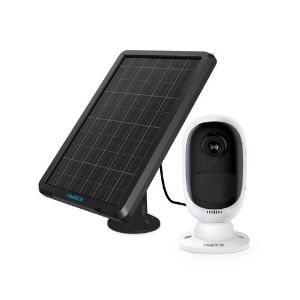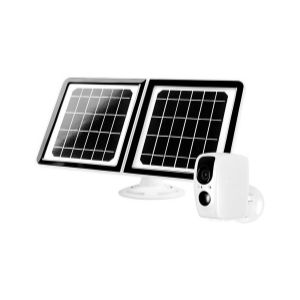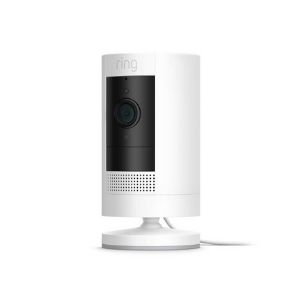The Best Solar-Powered Security Cameras
*Amazon.com price as of 04/13/2021 at 2:36 p.m. (MT). Read (full disclaimer)
Bottom line: Reolink’s Argus 2 comes out on top
We like the Reolink Argus 2 for its simple DIY setup, cheap price tag, and easy-to-use app. You can pick up the camera and solar panel for around $130, and it’s a snap to install. The Argus 2 also has impressive solar power, a good picture, and clear starlight night vision. Whether you’re trying to go green, save money on the power bill, or keep an eye on a garage or barn, this is a solid, affordable choice.
Top 4 solar security cameras

Compare the best solar-powered security cameras
*Amazon.com list price as of 04/13/2021 at 2:36 p.m. (MT). Read full disclaimer.
Reolink Argus 2: Best overall
When it comes to affordable outdoor wireless security, the Argus 2 delivers. This security camera is plug and play, and nearly every feature is customizable—from motion detector sensitivity to image resolution. In the app, you can configure the types of alerts and alarms you want and view a live video feed.
The camera also comes with two storage options: a micro SD card or seven days of free cloud storage. If you add extra cameras or want more cloud storage, Reolink also offers plans that can support up to 10 cameras with 30 days of storage.
Even though we think this is the biggest solar power security bang for your buck, there are a few drawbacks. Video is choppy, the motion detection lags, and our tester got a lot of false alarms. Read our full review to see how the Reolink Argus 2 performed in our hands-on test.
Lynx Solar Wi-Fi Surveillance Camera: Runner up
For a camera that uses solar power, the Lynx has a lot of high-tech bells and whistles. Our favorite is the facial recognition software. Not only does this help cut down on false alarms—it allows for customized alerts that let you know if a stranger is on your property.
We also like that the camera can charge for a full week with just one day of full sun. This smart security camera includes two-way audio and starlight night vision, and it works with Google Assistant for voice control. The camera records only in 10-second clips, so if a longer event triggers the camera, you may need to piece together multiple clips to get the full story.
While the video quality is good, the audio from the built-in speaker can be hard to understand—it breaks up a lot. Customers also report a decent delay between when you open the app and when the camera “wakes up.” But customer service gets rave reviews, so if you run into trouble with any of the advanced features, you can count on quick, responsive help.
Ring Stick Up Cam Solar: Affordable pick
The Ring Stick Up Cam provides extra security and convenience because it lets you interact with people on your property from your smartphone, laptop, or tablet. It was one of the first solar-powered security cameras to offer two-way talk, and it works with Amazon Alexa for voice control.
One of the coolest things about this outdoor security camera is that it can be part of the larger Ring Alarm security system. Most home security systems don’t offer solar power options, so this is a big advantage if you want to extend your home’s protection to more remote spots on your property.
Ring also offers a theft protection guarantee. If your Stick Up Cam gets snatched, Ring will replace it for free. But that’s one of the only things you get for free. Live video streaming comes standard, but if you want to record and save video, you’ll need a Ring Protect Plan, which starts around $3 a month.
- Use strong, unique passwords for all your accounts
- Opt for extra security measures like two-factor authentication
- Add shared users instead of sharing login credentials
- Change your home Wi-Fi password frequently
Maxsa Motion-Activated Solar Security Camera and Floodlight: Versatile pick
We like the Maxsa solar-powered home security device because it combines motion-activated floodlights with a wireless security camera to capture all the action on your property. All the settings are fully customizable, including how long the light stays on when activated and the sensitivity of both the motion sensor and the daylight trigger.
Even with adjustable settings, some customers still find the motion sensor to be too sensitive, triggering nearly constant recording but not always capturing movement in the videos. This is a glitch that can drain the battery quickly, especially when you’re counting on sunshine for power.
The camera comes with a 16GB memory card, but you can upgrade to a 64GB memory card or download video to a computer. One thing to note is that users have had a hard time getting the camera to sync up for proper date and time stamping. We recommend including that information in the name of any videos you download
Things to consider in a solar security camera
Placement
There are two things to consider when it comes to the placement of your solar-powered security camera. The first is where you want the camera to be installed for maximum protection, and the second is where the solar panel needs to be placed for maximum sun exposure.
To keep your solar-powered security camera up and running, you need enough peak sun-hours to get it fully charged. Peak sun-hours are classified as an hour in which the sun provides 1,000 watts of power per square mile. The measurement refers to the intensity of sunlight, rather than the amount of time the sun is shining.
Peak sun-hours typically occur when the sun is at its highest point and can vary depending on season and location. Some guidelines to help you harness as much solar power as possible include placing your solar panel in a south-facing spot that gets full sunlight for at least six hours per day.
Depending on how long the cable is that attaches your camera to the panel, you might need to adjust your choice for camera placement. We recommend identifying your desired camera placement before deciding which solar camera to buy.
Weatherproof rating
When you count on an outdoor device to keep your home and family safe, you need to make sure it can stand up to the elements. Every outdoor solar camera we recommend has a weatherproof rating that lets you know how well it withstands dust and water.
Weatherproof, or Ingress Protection (IP) ratings, rank devices and device casing based on how much dust and water can get into the device.
Water standards
Water standards range from IPX0 that offers zero protection from water to IPX7 that means the product can withstand 30 minutes of submersion in up to one meter of water. There is an IPX8 rating that is defined by the manufacturer as better than IPX7.
Dust standards
Dust standards range from IPX0 that indicates no protection against dust and other objects entering the device to IPX6, which means the device is impervious to dust and other objects.
IP ratings are often displayed as IP65, which indicates the waterproof rating first (6) followed by the dustproof rating. If you see a rating with an X in the middle, that means the item is rated only for one factor.
Solar camera FAQ
Because home security cameras need to be on the job 24/7, they can use up a good chunk of electricity. You’ll definitely keep your power bill from taking an extra hit with solar-powered cameras, but the amount of savings will vary from home to home.
Most of the solar-powered security cameras we recommend include rechargeable battery backup that can keep your camera working for anywhere from twelve hours to three days.
If you lose the Wi-Fi signal with the Lynx camera, it will keep recording video for three days. That footage is automatically uploaded to the cloud where you can access it even if your home Wi-Fi is down.
Related articles
Disclaimer
*Amazon.com list price as of 04/13/2021 at 02:36 p.m. (MT). Product prices and availability are accurate as of the date/time indicated and are subject to change. Any price and availability information displayed on Amazon at the time of purchase will apply to the purchase of this product. Safewise.com utilizes paid Amazon links.
Certain content that appears on this site comes from Amazon. This content is provided “as is” and is subject to change or removal at any time.
The post The Best Solar-Powered Security Cameras appeared first on SafeWise.
Article source here: The Best Solar-Powered Security Cameras




